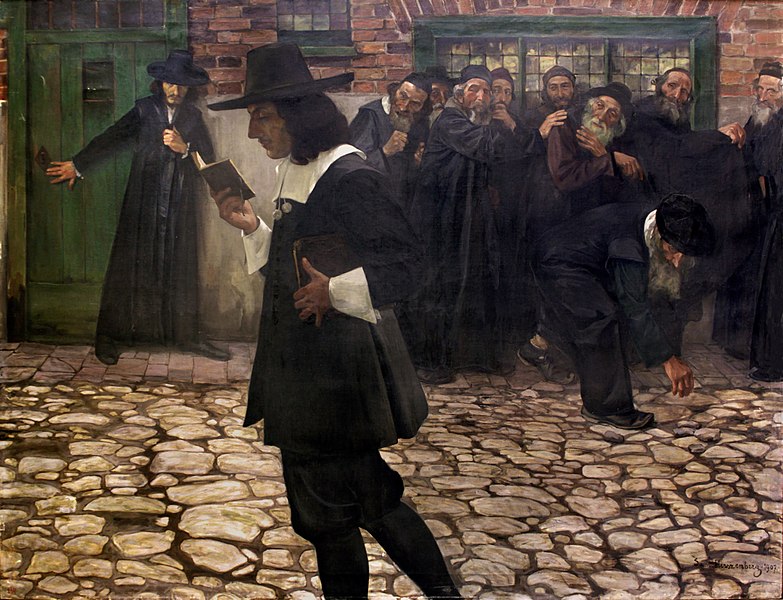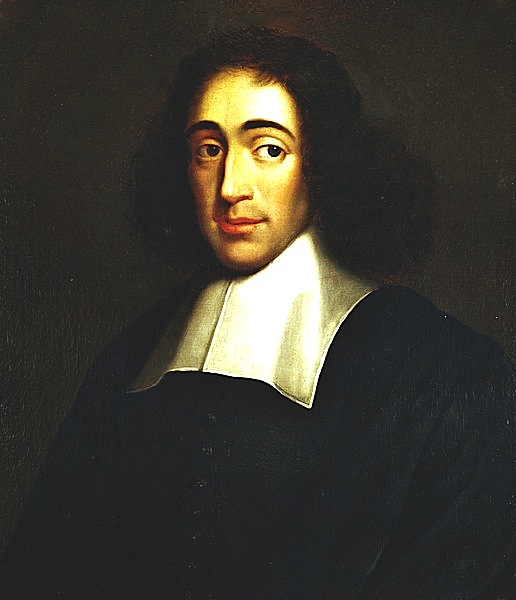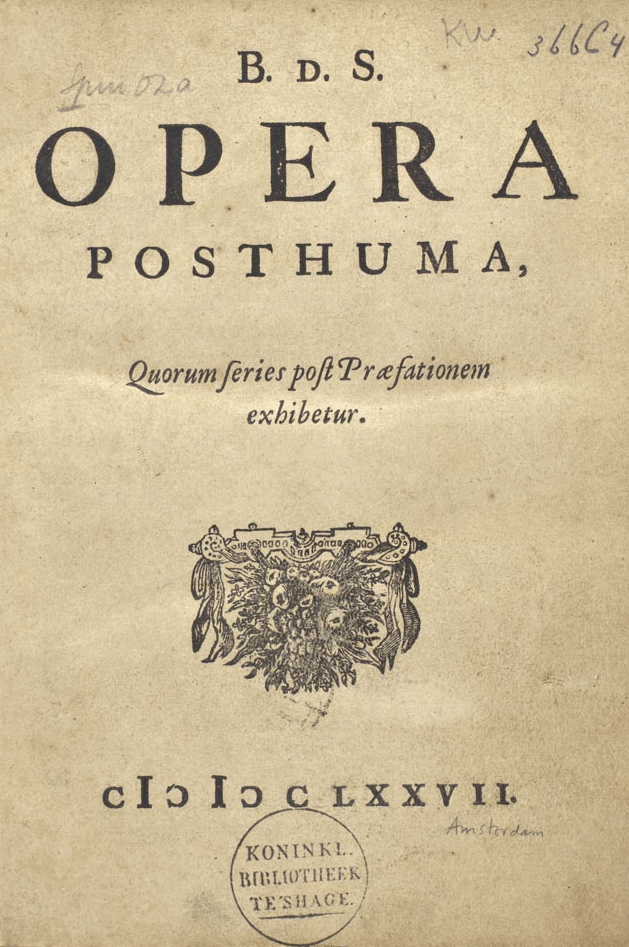
Excommunicated Spinoza, by Szmul Hirszenberg, 1907
スピノザに対する破門状(原文)
Document on the Excommunication of Baruch Spinoza, ברוך שפינוזה,
1632-1677

Excommunicated Spinoza, by Szmul Hirszenberg, 1907
以下は、スピノザに対する破門状(原文)である。スピノザの家族は、セ ファルディムのコンヴェルソであったため(ただしバルーフはアムステルダ ム生まれ)、この破門状も、ポルトガル語で回覧された可能性がある。この文章を翻訳した哲学者の渡辺義雄(渡辺 1996:54)は、原文をスペイン語と比定している。この原文は、"Espinosa e os Judeus de Amesterdão"(「アムステルダムにおけるスピノザとユダヤ人たち」)と称されたポルトガル語のサイト(→リンク先に明記)からの引用であること もお断りしておく。

スピノザに対する破門状(原文)
«Notta do Herem que se publicou da Theba em 6 de Ab, contra Baruch espinoza.
« Os SS. do Mahamad
fazer saber a vms: como ha diaz que tendo noticia das más opinioins e
obras de Baruch de espinoza, procurarão por differentes caminhos e
promessas, Retiralo de seus maos caminhos, e não Podendo remedialo,
antes pelo contrario tendo cada dia mayores noticias das horrendas
heregias, que practicava e ensinava e ynormes obras que obrava, tendo
disto muitas testemunhas fidedignas, que depugerao e testemunharão tudo
em prezensa de ditto espinoza, de que ficou convencido, o qual tudo
examinado em prezensa dos SS. Hahamim, deliberarao com seu pareçer, que
ditto espinoza seja enhermado e apartado da naçao de Israel, como
actualmente o poin em herem, com o Herem seguinte: «Com sentença dos
Anjos com ditto dos Santos, nos Enhermamos, apartamos e maidisoamos e
praguejamos a Baruch de espinoza, com consintimento dei D(eus)
B(endito) e consintimento de todo este K(ehila) K(adoscha) diante dos
santos sepharim estes, com os seis centos e treze preceitos, que estão
escritos nelles, com o herem, que enheremou Jehosuah a Jeriho, com a
maldissao, que maldisce Elisah a os Mossos, e com todas as maldisois,
que estao escrittas na ley, malditto seja de dia e malditto seja de
noite; maldito seja em seu deytar, e malditto seja em seu levantar;
malditto ele em seu sayr, e malditto elle em seu entrar; nao querera
A(donai) perdoar a elle, que entonces fumeara o furor de A. e seu zelo
neste homem, e yazera nelle todas as maldisois, as escritas no libro
desta Ley, e arrematara A. a seu nome debaixo dos Ceos, e apartaloa A.
para mal de todas as tribus de Ysrael, com todas as maldisois do
firmamento, as escritas no Libro da Ley esta; E vos os apegados com A.
vosso D.3 vivos todos vos oye. Advirtindo, que ninguem lhe pode falar
bocalmente, nem por escrito, nem dar lhe nenhum favor, nem debaixo de
tecto estar com ele, nem junto de quatro covados, nem leer papel algum
feito ou escritto por ele ».
リンク先
文献
Copyleft, CC, Mitzub'ixi Quq Chi'j, 1997-2099
Do not paste, but [Re]Think our message for all undergraduate students!!!


| Samuel Hirszenberg (also Schmul Hirschenberg) (Łódź, February 22, 1865 – September 15, 1908, Jerusalem) was a Polish-Jewish realist and later symbolist painter active in the late 19th and early 20th century. | サミュエル・ヒルゼンベルク(シュムル・ヒルシェンベルクとも)は、19世紀末から20世紀初頭にかけて活躍したポーランド系ユダヤ人のリアリズム画家で、後に象徴主義の画家となった。 |
| Biography Szmul (Samuel) Hirszenberg was born in 1865, the eldest son of a weaving mill worker in Polish Łódź. Against the will of his father, but thanks to the financial assistance of a doctor, he chose to be an artist. At the age of 15 he began his studies at the Academy of Fine Arts in Kraków, where he was heavily influenced by the realistic painting of Jan Matejko.[1] After two years of training in Kraków, he continued his studies from 1885-1889 at the Royal Academy of Arts in Munich.[2] |
略歴 スミュル・ヒルゼンベルクは1865年、ポーランドのウッチに織物工場労働者の長男として生まれる。父親の意に反し、医師の経済的援助もあって、芸術家の道を選んだ。15歳でクラクフの美術アカデミーに入学し、ヤン・マテイコの写実的な絵画に大きな影響を受ける[1]。 クラクフでの2年間の修行の後、1885年から1889年までミュンヘンの王立芸術アカデミーで勉強を続けた[2]。 |
| Art career "The Last Prayer," Hirszenberg, Ein Harod His first major work to attract attention was Yeshiva (1887). After an exhibition at the Kunstverein Munich (1889), he showed at the art exhibition in Paris and was awarded a silver medal. In Paris, he completed his artistic training at the Académie Colarossi. The Wandering Jew (1899), Israel Museum In 1891, Hirszenberg returned to Poland. In 1893 he resettled in his hometown of Łódź. While the images of the early years, like the paintings Talmudic Studies, Sabbathnachmittag, Uriel Acosta, and The Jewish cemetery show a certain kinship with the Jewish genre painting by Leopold Horowitz, Isidor Kaufmann, and Maurycy Gottlieb, his later works can be rather assigned to the symbolism. Themes of the "tearful" Jewish history came to the fore. Noteworthy are the three most famous pictures of this period: The Wandering Jew (1899), Exile (1904), and Czarny Sztandar / Black Banner (1905). In 1900, after working on a large painting, "The Eternal Jew," for over four years, it was exhibited in the Paris Salon. Disappointed by the poor response in Paris Munich and Berlin, he retired for health reasons.[3] In 1901, he went for a year on a trip to Italy. In 1904, Hirszenberg moved to Kraków. In 1907, he immigrated to Palestine and began to work as a lecturer at the newly founded Bezalel School in Jerusalem, headed by Boris Schatz. After a short and intense creative period, he died in 1908 in Jerusalem.[4] |
画業 「最後の祈り」ヒルゼンベルク、アイン・ハロッド 最初に注目を集めた大作は《Yeshiva》(1887年)。ミュンヘン芸術協会での展覧会(1889年)の後、パリの美術展に出品し、銀賞を受賞。パリでは、アカデミー・コラロッシで芸術修業を積む。 さまよえるユダヤ人』(1899年)、イスラエル美術館蔵 1891年、ヒルゼンベルクはポーランドに戻る。1893年には故郷のロチュに定住した。タルムード研究』、『安息日』、『ウリエル・アコスタ』、『ユダ ヤ人の墓地』といった初期のイメージは、レオポルド・ホロヴィッツ、イシドール・カウフマン、モーリシー・ゴットリーブらによるユダヤ風俗画との親近性を 示しているが、後期の作品はむしろ象徴主義に帰することができる。涙ぐましい」ユダヤ史のテーマが前面に押し出されるようになった。特筆すべきは、この時 期の最も有名な3枚の絵である: さすらうユダヤ人』(1899年)、『亡命』(1904年)、『黒い旗』(1905年)である。 1900年、4年以上かけて制作した大作『永遠のユダヤ人』がパリ・サロンに出品された。パリ・ミュンヘンとベルリンでの反応の悪さに失望した彼は、健康上の理由から引退した[3]。 1901年、1年間のイタリア旅行。1904年、クラクフに移住。1907年、パレスチナに移住し、ボリス・シャッツが主宰するエルサレムのベザレル音楽学校で講師として働き始める。短期間の激しい創作活動の後、1908年にエルサレムで死去した[4]。 |
| https://en.wikipedia.org/wiki/Samuel_Hirszenberg |
|
Samuel Hirszenberg (also Schmul Hirschenberg) (Łódź, February 22, 1865 – September 15, 1908, Jerusalem)